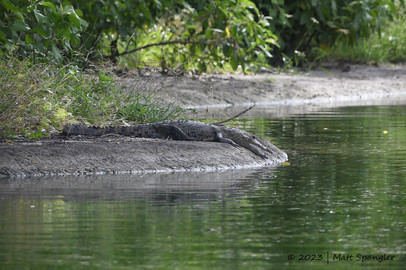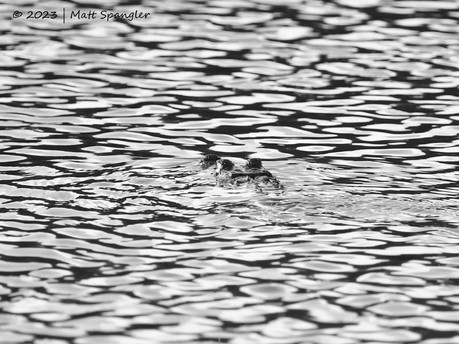Standard disclaimer: This is the third of three blogs featuring nature adventures incidental to wedding weekends this year. As my wife is keen to remind me: Remember, Matt, this isn’t a birding trip; we’re here for the wedding. I wholeheartedly agree. But when people get married in particularly special places, I tend to use my spare time exploring the natural world. That’s what this blog will cover.
On with the story: This November, my wife and I made a very short, but very sweet, trip to the Yucatán Peninsula for a friend’s wedding. This was my first visit to Mexico, and it was a nice introduction to the Caribbean. We stayed at the Fairmont Mayakoba, one of several luxury resorts inside a 600-acre compound. In addition to the resorts and an apparently famous golf course, the compound also featured a nice array of forests, mangroves, canals, lagoons, and a beach. As you can imagine, I/we did a lot of exploring in between the social events. The weather was pretty good, notwithstanding the heat and unpredictable rain showers. The only real problem was the duration: two nights was simply not enough time to experience Mayakoba, much less the surrounding Yucatán or Mexico in general (we never left the compound).

Friday
Pre-adventure staging included an early flight out of Charlotte, a mid-morning arrival in Mexico, a short and uneventful trip through customs (way quicker than Scotland), a transfer from the Cancun airport to Mayakoba, and a nice lunch. After all that, we started exploring with a walk along a paved nature trail. I don’t often use the word “paved” near “nature,” but this trail provided plenty of wildlife encounters as it weaved through a variety of habitats. Mid-afternoon isn’t a great time for birding—think siesta—but I still managed to see 8 lifers: Golden-fronted Woodpecker, Great Kiskadee, Social Flycatcher, Tropical Kingbird, Yucatan Jay, Tropical Mockingbird, Orange Oriole, and Altamira Oriole. The gregarious (and common) Yucatan Jay was probably my favorite bird species of the trip, followed by the various colorful oriole species.
The mid-afternoon warm weather brought out lots of cold-blooded animals. Black Spiny-tailed Iguanas were everywhere (including one eating a bat!). Brown Basilisks—also called Jesus lizards, as they can run across water—were also plentiful, as were the more mundane Brown Anoles. A freshwater pond hosted a crocodile (either American or Morelet’s; I’m still waiting on some help with the ID), some Mesoamerican Sliders, and a Mayan Cichlid. Pretty much all of those species (except the anoles) were lifers.
Tracking down fast-moving insects requires a more concerted effort than I had time for, so I didn’t identify many of the invertebrates we encountered. But I was able to ID two new butterflies: Gray Cracker and Red Postman; some familiar-but-exciting Zebra Longwings; and one new dragonfly: a Brown Setwing. We only encountered one mammal on our walk: the Yucatan Squirrel, which is similar to our Eastern Gray Squirrel, but with a bushier tail.
After checking into our room, we boarded a small boat for a private tour of Mayakoba’s canals and lagoons. Most of the canals were man-made, but nonetheless scenic. A portion of the waterway took us over a natural streambed that was once underground, connected to a vast network of subterranean streams, caves, and cenotes that permeate the Yucatán limestone. This was one of my favorite parts of the trip; this should come as no surprise, as I love the unique perspective of viewing land from the water. The only thing better would have been kayaking the canals, but the boat kept us dry during an unexpected downpour.

The boat afforded us close looks at animals that would otherwise be tough to see. The most exciting sighting was a pair of lifer Boat-billed Herons. Couch’s Kingbird was another lifer, only distinguishable from the aforementioned Tropical Kingbird by voice. Other cool birds included Limpkin, Neotropic Cormorant, and a variety of species that we also have back in North Carolina. Nonavian sightings included a handful more Black Iguanas, a massive Green Iguana (actually orange-colored), dozens more sliders, and some interesting arboreal termites in the mangroves.
My last adventure of the day involved a short trek through the mangroves to the beach and back. It was fairly quiet in terms of wildlife, but I managed to see a couple Plain Chachalacas on the roof of a nearby casita, some Melodious Blackbirds foraging on a lawn (both lifers), and a photogenic Great Kiskadee.
The rest of the night was devoted to people time, save for a handful of bats foraging during the reception.
Saturday
I awoke before dawn on Saturday (surprise!), but rain showers pinned me down until the sun came up.

Once the rain abated, I went on a long birding walk to the beach and around the golf course (pre-tee-time). I encountered an impressive 51 bird species, including 5 more lifers: Boat-billed Flycatcher, Brown Jay, Rufous-browed Peppershrike, Yucatan Vireo, and Hooded Oriole. It was a good opportunity to compare the Boat-billed Flycatcher (huge bill) with doppelgangers Great Kiskadee (medium bill) and Social Flycatcher (small bill).
Other cool birds included a dozen Chachalacas, a flock of Bronzed Cowbirds, a dozen Vaux’s Swifts, some unidentified parakeets/parrots, tons of shorebirds on the golf course, and a half dozen familiar North American warblers that overwinter in Mexico.
The morning walk also featured some notable nonavian species, including a troupe of 35 White-nosed Coatis (raccoon relatives), some unidentified house geckos, a Brown Basilisk that I actually saw run across the water, and one new damselfly: a Peten Dancer.
After rejoining my wife for a big breakfast, we hopped on bikes and checked out the northwestern parts of the compound. Early in the journey, a raucous Roadside Hawk screeched overhead, adding one more lifer to my list. We spent most of our time underground in el Cenote Burrodromo, an underground cavern connected to the aforementioned system of caves and waterways. Unsurprisingly, we saw a couple dozen bats clinging to the ceiling (some species of long-nosed bat?). More surprisingly, we saw some fish—the ubiquitous Mayan Cichlid and a couple cave-dwelling Pale Catfish. It was also neat to see tree roots penetrating the cave ceiling from the forest above. Above-ground critters near the cave included a new species of mantis and a bunch of Mayan Meliponas (native stingless bees).
We next made a quick stop at “El Pueblito,” a self-contained village square on the Mayakoba property. I found some leafcutter ants particularly interesting.
We spent the rest of the pre-wedding afternoon chilling and walking on the beach, like normal people do. Although the Caribbean views were interrupted by a system of breakwalls, the structures provided much-needed shelter as we kayaked, paddleboarded, and swam along the beach.

The beach featured your standard fare of coastal wildlife, not much different from what you’d see on the American Atlantic coast. The most exciting tropical specialists were Magnificent Frigatebirds, present in large numbers. It was also interesting to see a falconer patrolling the beach with a Harris’s Hawk, trained to scare off the omnipresent Great-tailed Grackles looking for an opportunistic meal.
The outdoor wedding was as beautiful as you might imagine. Uninvited (but not unexpected) guests included several avian species, including an unidentified hummingbird (this one stayed outside, unlike the hummer at the recent wedding we attended in California).
Sunday
Sunday featured a slower start than Saturday, but I made the best of the morning with one final lap around the golf course and nature trails. In addition to repeat birds seen over the preceding two days, I finally got close enough looks to identify a pair of Cinnamon Hummingbirds, my last bird lifer of the trip. The charming Chachalacas also offered some nice photo-ops.
The herps put on a predictably good show. Two were new, including a White-lipped Mud Turtle and an unidentified anole. There are apparently 46 different species of anoles in Mexico, and many are basically unidentifiable without a good look at the dewlap (the crazy colorful neck thing). I also encountered more of the usual suspects, including a Brown Basilisk, a/the unidentified Crocodile, more Mesoamerican Sliders and Mayan Cichlids, a Yucatan Squirrel, and a new orchard orbweaver spider.
After another big breakfast, I officially decided that chilaquiles are my favorite Mexican food. We spent the rest of the day waiting for a shuttle, transferring to the airport, waiting in the airport, flying back to Charlotte, then driving back home. It was a lot of travel for a short (but sweet) trip.
Summary by the Numbers
We covered 2100 miles by airplane, 300 by car, 50 by taxi, 13 on foot, 4 or 5 by bike, 3 by boat, and 1 by kayak (me) and SUP (wife). I observed approximately 65 bird species, 19 of which were lifers (bringing me to 582). As noted in my recent California wedding blog, I don’t actively try for “big years,” but I can’t help but note that 25 of these birds were new for my 2023 list, bringing me to 441 species for the year. Again, that’s a good indicator of how much I’ve traveled!
Beyond birds, reptiles were the main star. I saw 9 different species, 6 or 7 of which were new (to me). Of the 3 or 4 species of mammals, all were new. Most of the 17 or so species of invertebrates were also new. Again, I didn’t have enough time to explore the diversity of tropical insect life here—there’s always something to look forward to next time!














































































































































